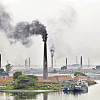Air pollution linked to osteoporosis-related bone fractures

Beyond the risks of cardiovascular disease, respiratory disease and even cancer, living in a highly polluted zone for a significant time could increase the risk of osteoporosis-related bone fracture, especially in older people, according to two new American studies published in the journal The Lancet Planetary Health.
Exposure to high levels of fine particulate matter (PM2.5) in the atmosphere could accelerate bone density loss and increase the risk of fracture, according to researchers at Columbia University's Mailman School of Public Health, New York.
Like the toxic substances in cigarette smoke, air pollution could cause inflammation and oxidative stress, leading to bone loss.
The researchers came to this conclusion by means of two parallel studies. In the first, they studied hospital admissions between 2003 and 2010 for osteoporosis-related fractures in patients over 65 years old. The results indicated that even small increases in fine particle concentrations could lead to an increase in bone fractures in older adults.
In the second study, the scientists followed 692 men from low-income backgrounds in the region of Boston over the same period. Participants' average age was 47. They found that adults living in areas with high levels of fine particles and black carbon -- a pollutant from automotive emissions -- had lower levels of parathyroid hormone, a key calcium and bone-related hormone.
The researchers also found that participants in the study had greater decreases in bone density than men exposed to lower levels of these pollutants.
In April, the same team of experts published research reporting that B vitamins (50mg of B6, 2.5mg of B9, 1mg of B12) could diminish the toxic effects of air pollution on the immune and cardiovascular systems. However, scientists are currently unsure whether the benefits of B vitamins extend to bone loss.
The researchers report that there are an estimated two million osteoporosis-related bone fractures in the USA each year.
The researchers conclude that, like smoking and lack of physical exercise, air pollution is a risk factor for bone fractures.
The study is available here: Association of air particulate pollution with bone loss over time and bone fracture risk

 For all latest news, follow The Daily Star's Google News channel.
For all latest news, follow The Daily Star's Google News channel. 








Comments